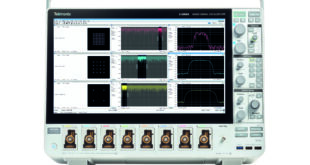The average global internet user is reported to spend seven hours online per day. With the number of internet users expected to grow to 5.3 billion by 2023, the need for more bandwidth is increasing. Marcin Bala explains how coherent optics can help cope with demand
Before coherent transmission was introduced, all optics were based on a simple mechanism known as on-off keying (OOK). In simple terms, this mechanism works by switching a light on and off to transmit data. However, this technology has almost reached its frequency limit, resulting in the necessity to find new methods to send more data without laying more fibre strands. This is where coherent optics comes in.
Coherent optics can solve capacity issues by modulating amplitude, frequency and polarisation, allowing more information to be transported on the same fibre.
To make things easier, imagine a sea wave through which information can be sent. In OOK-based communications systems, we could only decide whether the wave was visible or not. Let’s assume the amplitude refers to the wave’s height, and that we manage to manipulate it. If we could distinguish four different heights, we could send much more information within the same time frame.
Similarly, imagine that frequency refers to when the crest of a wave reaches the shore, and that this is an interval of 60 seconds. By modifying this parameter and having crests reach the shore more frequently, we could send much more data.
Now, imagine that the same wave could undulate not just vertically, but also horizontally, and that the two movements could be combined — you would be able to carry twice as much information. This is what happens when we modify polarisation.
Combining these three techniques simultaneously complicates the signal and achieves very high throughput. For example, 400G QSFP-DD optics that is modulated using 16QAM and 64Gbaud has the capacity for 64 billion light changes per second.
DWDM technology
With coherent optics comes various new technologies, including dense wavelength division multiplexing (DWDM).
WDM technology enables the capacity of a single fibre to be multiplied, allowing for multiple different wavelengths to be transmitted on one fibre. This is done by multiplexing many signals with different wavelengths into a single fibre. DWDM varies from the original WDM technology as it comes in two types — fixed grid and flex grid. The fixed grid has the capacity for 48 channels with 100 GHz spacing, 64 channels with 75 GHz spacing, or 96 channels with 50 GHz spacing. Flex grid DWDM, on the other hand, does not have any channel numbers as spacing is dynamic, allowing each channel to have a different passband.
WDM technology is not new, but its application to coherent transmission is. Currently, only DWDM can support both OOK and coherent transmission. This and the technology’s capacity to be amplified, making it largely universal, is likely why it is the most popular WDM technology.
QSFP-DD for increased capacity
A quad small form-factor pluggable double-density (QSFP-DD) interface differs from previous standards as it is longer than QSFP+ and QSFP28, because it has additional rows of PINs. This means that instead of the previous four data paths, the QSFP-DD has eight, with each path having a throughput of 56Gb/s, meaning a combined total of 400G for a single transceiver. This massively increases the amount of information the interface can handle.
Another way the technology differs is in power dissipation. It has over double the max power consumptions of the QSFP28, allowing for enough energy to operate coherent DSP. This is useful as network planners can skip the use of transponders or muxponders for their DWDM network. This technology can save companies up to 50 per cent in initial investments and up to 90 per cent in power consumption.
400G or 800G?
At the moment, there are many types of 400G transceivers on the market. There are QSFP-DD transceivers with a MPO connector that allows network planners to stack four times 100G to a single 400G port, and others with duplex LC connectors to build fully 400G interconnection. However, the most interesting ones are the coherent types, OIF 400ZR and MSA OpenZR+. 400ZR are designed for data centre interconnection, whereas OpenZR+ can be used for longer distances not only by data centres but also by telco operators.
However, GBC Photonics is going one step further by developing a new transceiver to beat the 400G throughput. The transceiver will be similar to the QSFP-DD in size and PIN design, but the data path speed will differ. The speed will be upgraded to 112Gb/s with eight data paths, achieving 800G from a single transceiver.
The telecommunications industry needs to rapidly evolve to keep up with the demand for more bandwidth. For this reason, the popularity of coherent optics is expected to increase as companies seek to optimise data transmissions and extend wavelength capacity, without necessarily having to lay more fibre.
Marcin Bala is CEO of telecommunications equipment manufacturer GBC Photonics.
 Engineer News Network The ultimate online news and information resource for today’s engineer
Engineer News Network The ultimate online news and information resource for today’s engineer





